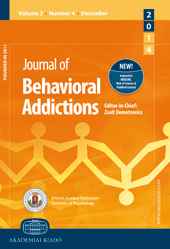Putative Dopamine Agonist (KB220Z) Attenuates Lucid Nightmares in PTSD Patients: Role of Enhanced Brain Reward Functional Connectivity and Homeostasis Redeeming Joy
Putative Dopamine Agonist (KB220Z) Attenuates Lucid Nightmares in PTSD Patients: Role of Enhanced Brain Reward Functional Connectivity and Homeostasis Redeeming Joy
Author(s): Becky McLaughlin, Thomas Mclaughlin, Kenneth Blum, Marlene Oscar-Berman, Marcelo Febo, Gozde Agan, James L. Fratantonio, Thomas Simpatico, Mark S. GoldSubject(s): Cognitive Psychology, Developmental Psychology, Experimental Pschology, Neuropsychology, Behaviorism
Published by: Akadémiai Kiadó
Keywords: putative complex dopamine agonist; KB220Z; parasomnia; functional brain connectivity; lucid nightmares; Post-Traumatic Stress Disorder (PTSD);
Summary/Abstract: Lucid dreams are frequently pleasant and training techniques have been developed to teach dreamers to induce them. In addition, the induction of lucid dreams has also been used as a way to ameliorate nightmares. On the other hand, lucid dreams may be associated with psychiatric conditions, including Post-Traumatic Stress Disorder (PTSD) and Reward Deficiency Syndrome-associated diagnoses. In the latter conditions, lucid dreams can assume an unpleasant and frequently terrifying character. Case presentations: We present two cases of dramatic alleviation of terrifying lucid dreams in patients with PTSD. In the first case study, a 51-year-old, obese woman, diagnosed with PTSD and depression, had attempted suicide and experienced terrifying lucid nightmares linked to sexual/physical abuse from early childhood by family members including her alcoholic father. Her vivid “bad dreams” remained refractory in spite of 6 months of treatment with Dialectical Behavioral Therapy (DBT) and standard pharmaceutical agents which included prazosin, clonidie and Adderall. The second 39-year-old PTSD woman patient had also suffered from lucid nightmares. Results: The medication visit notes reveal changes in the frequency, intensity and nature of these dreams after the complex putative dopamine agonist KB220Z was added to the first patient’s regimen. The patient reported her first experience of an extended period of happy dreams. The second PTSD patient, who had suffered from lucid nightmares, was administered KB220Z to attenuate methadone withdrawal symptoms and incidentally reported dreams full of happiness and laughter. Conclusions: These cases are discussed with reference to the known effects of KB220Z including enhanced dopamine homeostasis and functional connectivity of brain reward circuitry in rodents and humans. Their understanding awaits intensive investigation involving large-population, double-blinded studies.
Journal: Journal of Behavioral Addictions
- Issue Year: 4/2015
- Issue No: 2
- Page Range: 106-115
- Page Count: 10
- Language: English

